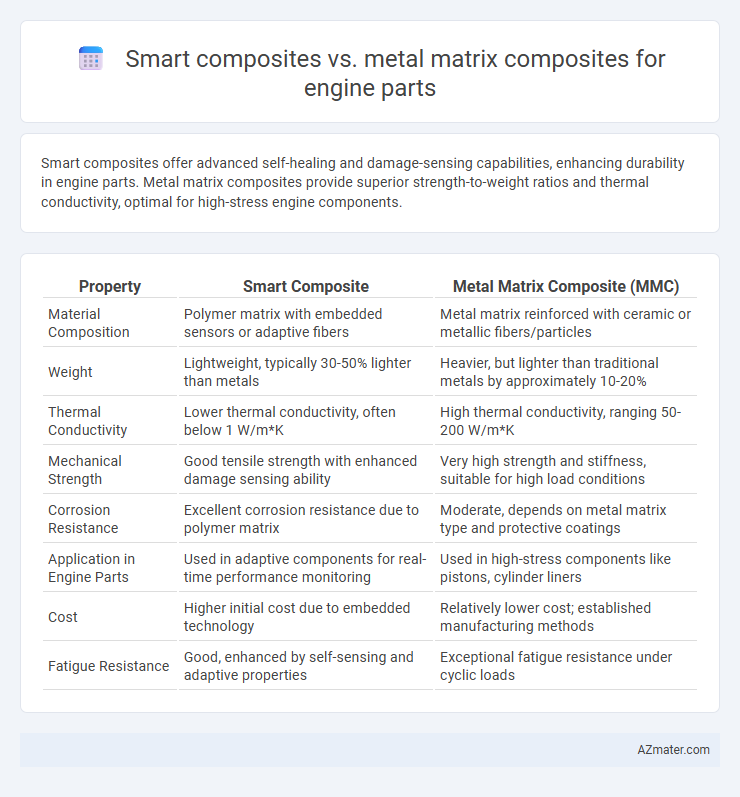Smart composites offer advanced self-healing and damage-sensing capabilities, enhancing durability in engine parts. Metal matrix composites provide superior strength-to-weight ratios and thermal conductivity, optimal for high-stress engine components.
Table of Comparison
| Property | Smart Composite | Metal Matrix Composite (MMC) |
|---|---|---|
| Material Composition | Polymer matrix with embedded sensors or adaptive fibers | Metal matrix reinforced with ceramic or metallic fibers/particles |
| Weight | Lightweight, typically 30-50% lighter than metals | Heavier, but lighter than traditional metals by approximately 10-20% |
| Thermal Conductivity | Lower thermal conductivity, often below 1 W/m*K | High thermal conductivity, ranging 50-200 W/m*K |
| Mechanical Strength | Good tensile strength with enhanced damage sensing ability | Very high strength and stiffness, suitable for high load conditions |
| Corrosion Resistance | Excellent corrosion resistance due to polymer matrix | Moderate, depends on metal matrix type and protective coatings |
| Application in Engine Parts | Used in adaptive components for real-time performance monitoring | Used in high-stress components like pistons, cylinder liners |
| Cost | Higher initial cost due to embedded technology | Relatively lower cost; established manufacturing methods |
| Fatigue Resistance | Good, enhanced by self-sensing and adaptive properties | Exceptional fatigue resistance under cyclic loads |
Introduction to Engine Component Materials
Engine component materials demand high strength, thermal stability, and wear resistance, making smart composites and metal matrix composites (MMCs) crucial options. Smart composites integrate responsive materials to adapt to changing conditions, enhancing performance and durability in dynamic engine environments. Metal matrix composites combine metals with reinforcing fibers or particles, offering superior stiffness, heat resistance, and reduced weight compared to traditional alloys in critical engine parts.
Overview of Smart Composites
Smart composites integrate sensors and actuators within matrix materials to provide real-time monitoring and adaptive responses in engine parts. These materials enhance performance by detecting stress, temperature, and damage while enabling self-healing or shape change, unlike traditional metal matrix composites which primarily offer high strength and thermal conductivity. The embedded intelligence in smart composites allows for improved durability, safety, and efficiency in automotive and aerospace engine applications.
Understanding Metal Matrix Composites (MMCs)
Metal Matrix Composites (MMCs) consist of a metal matrix embedded with reinforcing fibers or particles, offering superior strength, thermal conductivity, and wear resistance compared to traditional metals. Engine parts made from MMCs benefit from enhanced mechanical properties and improved high-temperature performance, crucial for demanding automotive and aerospace applications. Understanding the microstructure and interface bonding in MMCs is essential for optimizing their durability and efficiency in engine environments.
Key Material Properties Comparison
Smart composites offer superior corrosion resistance, reduced weight, and enhanced fatigue life compared to traditional metal matrix composites, which are known for their high thermal conductivity and exceptional mechanical strength. Metal matrix composites typically provide better high-temperature stability and wear resistance, making them suitable for engine components exposed to extreme thermal and mechanical stresses. The choice between smart and metal matrix composites depends on balancing the need for lightweight performance and self-healing capabilities against the requirement for heat tolerance and structural rigidity in engine parts.
Mechanical Performance in Engine Environments
Smart composites exhibit enhanced mechanical performance in engine environments due to their adaptive properties, such as self-healing and vibration damping, which improve durability and reduce fatigue damage. Metal matrix composites (MMCs) offer superior strength, stiffness, and thermal conductivity, making them ideal for high-stress engine components exposed to extreme temperatures and mechanical loads. While MMCs excel in load-bearing and heat resistance, smart composites provide intelligent responses to dynamic engine conditions, optimizing overall mechanical performance and component lifespan.
Thermal Stability and Heat Resistance
Smart composites exhibit superior thermal stability and heat resistance compared to traditional metal matrix composites, enabling engine parts to withstand higher operating temperatures without degradation. The incorporation of advanced reinforcements like ceramic nanoparticles in smart composites enhances thermal conductivity and reduces thermal expansion, crucial for maintaining dimensional stability under thermal stress. In contrast, metal matrix composites, while durable, often face challenges with thermal fatigue and oxidation at elevated temperatures, limiting their long-term performance in high-heat engine environments.
Weight Reduction and Fuel Efficiency
Smart composites offer significant weight reduction compared to traditional metal matrix composites, enhancing engine part performance by lowering overall mass. The decreased weight directly contributes to improved fuel efficiency by reducing the energy required for engine operation. Advanced smart composites also provide adaptive properties that optimize durability and strength while maintaining lightweight characteristics essential for fuel economy.
Cost Analysis and Manufacturing Challenges
Smart composites offer cost advantages over metal matrix composites (MMCs) due to lower material and processing expenses, enabling more economical production of engine parts. MMCs, while providing superior thermal stability and mechanical strength, often incur higher costs from complex manufacturing techniques such as powder metallurgy, casting, or infiltration. Manufacturing challenges for MMC engine components include difficulties in achieving uniform particle dispersion and managing thermal expansion, whereas smart composites typically benefit from easier fabrication and improved adaptability in design.
Case Studies: Engine Applications
Smart composites in engine parts demonstrate adaptive properties such as self-sensing and damage detection, enhancing real-time monitoring capabilities under thermal and mechanical stresses. Metal matrix composites (MMCs), commonly used in engine cases, provide superior thermal conductivity, wear resistance, and strength-to-weight ratio, significantly improving engine durability and efficiency. Case studies on engine cylinder liners and piston components reveal MMCs reduce weight and fuel consumption, while smart composites enable predictive maintenance, collectively advancing engine performance and longevity.
Future Trends in Engine Composite Materials
Smart composites, integrating sensors and actuators within metal or polymer matrices, are evolving to enhance real-time monitoring and adaptive performance in engine parts, pushing the boundaries of reliability and efficiency. Metal matrix composites (MMCs) continue to advance with improved thermal conductivity, wear resistance, and lightweight properties, essential for high-temperature engine environments and fuel efficiency. Future trends emphasize hybrid smart MMCs combining embedded intelligence with superior mechanical properties to meet stringent requirements of next-generation engines.

Infographic: Smart composite vs Metal matrix composite for Engine part
 azmater.com
azmater.com